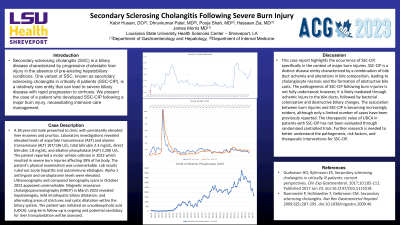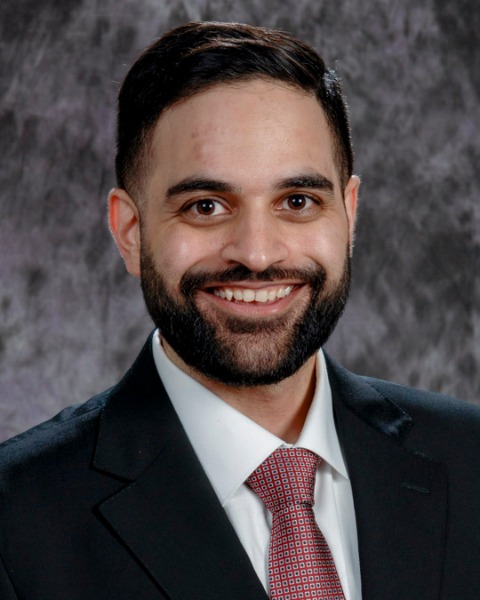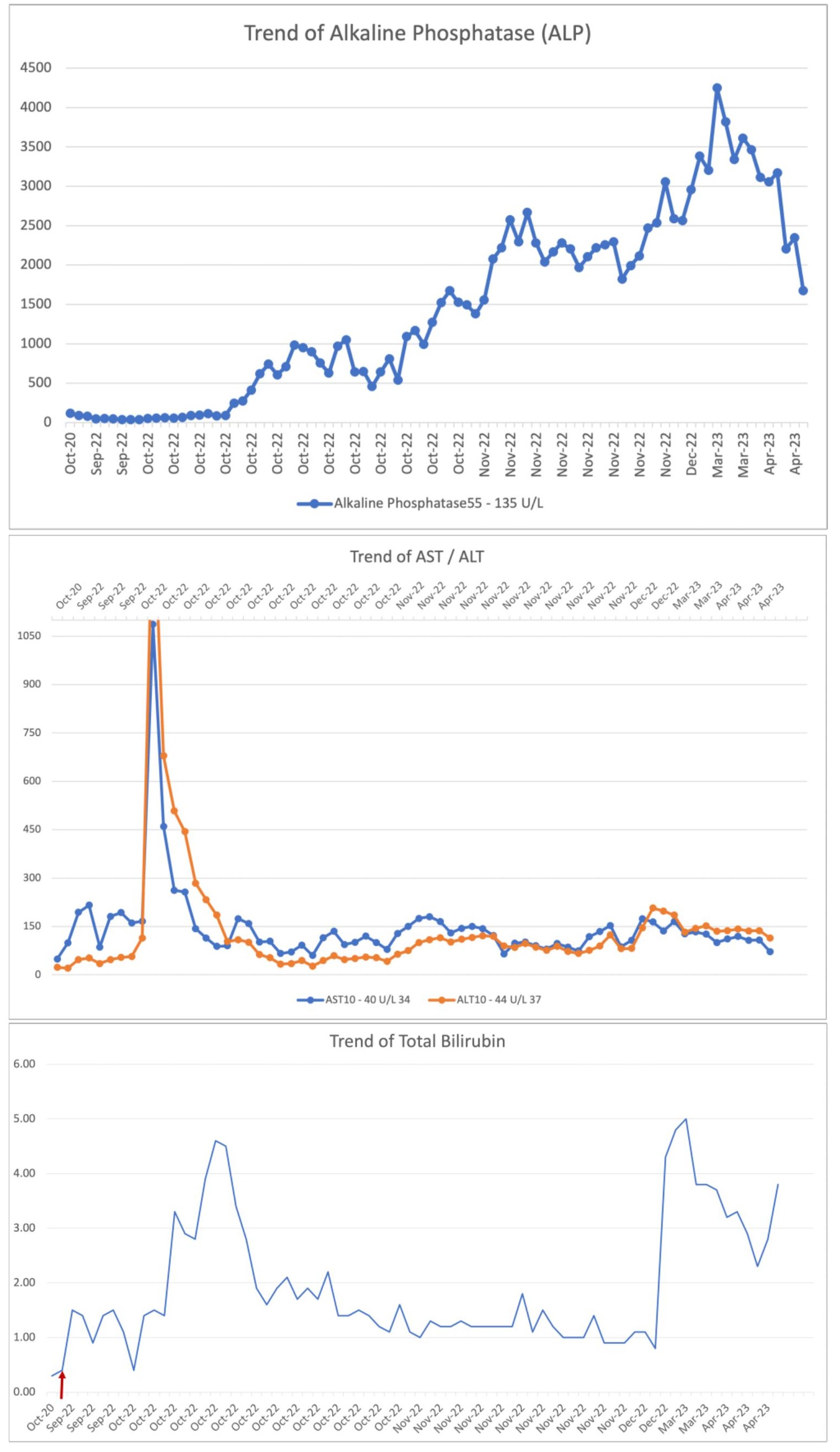Monday Poster Session
Category: Biliary/Pancreas
P1523 - Secondary Sclerosing Cholangitis Following Severe Burn Injury
Monday, October 23, 2023
10:30 AM - 4:15 PM PT
Location: Exhibit Hall

Has Audio

Kabir Husain, DO
LSU Health Sciences Center
Shreveport, Louisiana
Presenting Author(s)
Kabir Husain, DO, Dhruvkumar Patel, MBBS, Pooja Shah, MD, Hassaan A. Zia, MD, James Morris, MD
LSU Health Sciences Center, Shreveport, LA
Introduction: Secondary sclerosing cholangitis (SSC) is a biliary disease characterized by progressive cholestatic liver injury in the absence of pre-existing hepatobiliary conditions. One variant of SSC, known as secondary sclerosing cholangitis in critically ill patients (SSC-CIP), is a relatively rare entity that can lead to severe biliary disease with rapid progression to cirrhosis. We present the case of a patient who developed SSC-CIP following a major burn injury, necessitating intensive care management.
Case Description/Methods: A 38-year-old male presented to clinic with persistently elevated liver enzymes and pruritus. Laboratory investigations revealed elevated levels of aspartate transaminase (AST) and alanine transaminase (ALT) 107/136 U/L, total bilirubin 2.3 mg/dL, direct bilirubin 1.8 mg/dL, and alkaline phosphatase (ALP) 2,206 U/L. The patient reported a motor vehicle collision in 2022 which resulted in severe burn injuries affecting 39% of his body.The patient's physical examination was unremarkable. Lab results ruled out acute hepatitis and autoimmune etiologies. Alpha-1 antitrypsin and ceruloplasmin levels were elevated. Ultrasonography and computed tomography scans in October 2022 appeared unremarkable. Magnetic resonance cholangiopancreatography (MRCP) in March 2023 revealed hepatomegaly, mild intrahepatic biliary dilatation, and alternating areas of strictures and cystic dilatation within the biliary system. The patient was initiated on ursodeoxycholic acid (UDCA). Long-term follow-up is ongoing and potential candidacy for liver transplantation will be assessed.
Discussion: This case report highlights the occurrence of SSC-CIP, specifically in the context of major burn injuries. SSC-CIP is a distinct disease entity characterized by a combination of bile duct ischemia and alterations in bile composition, leading to cholangiocyte necrosis and the formation of obstructive bile casts. The pathogenesis of SSC-CIP following burn injuries is not fully understood; however, it is likely mediated through ischemic injury to the bile ducts, followed by bacterial colonization and destructive biliary changes. The association between burn injuries and SSC-CIP is becoming increasingly evident, although only a limited number of cases have been previously reported. The therapeutic value of UDCA in patients with SSC-CIP has not been evaluated through randomized controlled trials. Further research is needed to better understand the pathogenesis, risk factors, and therapeutic interventions for SSC-CIP.

Disclosures:
Kabir Husain, DO, Dhruvkumar Patel, MBBS, Pooja Shah, MD, Hassaan A. Zia, MD, James Morris, MD. P1523 - Secondary Sclerosing Cholangitis Following Severe Burn Injury, ACG 2023 Annual Scientific Meeting Abstracts. Vancouver, BC, Canada: American College of Gastroenterology.
LSU Health Sciences Center, Shreveport, LA
Introduction: Secondary sclerosing cholangitis (SSC) is a biliary disease characterized by progressive cholestatic liver injury in the absence of pre-existing hepatobiliary conditions. One variant of SSC, known as secondary sclerosing cholangitis in critically ill patients (SSC-CIP), is a relatively rare entity that can lead to severe biliary disease with rapid progression to cirrhosis. We present the case of a patient who developed SSC-CIP following a major burn injury, necessitating intensive care management.
Case Description/Methods: A 38-year-old male presented to clinic with persistently elevated liver enzymes and pruritus. Laboratory investigations revealed elevated levels of aspartate transaminase (AST) and alanine transaminase (ALT) 107/136 U/L, total bilirubin 2.3 mg/dL, direct bilirubin 1.8 mg/dL, and alkaline phosphatase (ALP) 2,206 U/L. The patient reported a motor vehicle collision in 2022 which resulted in severe burn injuries affecting 39% of his body.The patient's physical examination was unremarkable. Lab results ruled out acute hepatitis and autoimmune etiologies. Alpha-1 antitrypsin and ceruloplasmin levels were elevated. Ultrasonography and computed tomography scans in October 2022 appeared unremarkable. Magnetic resonance cholangiopancreatography (MRCP) in March 2023 revealed hepatomegaly, mild intrahepatic biliary dilatation, and alternating areas of strictures and cystic dilatation within the biliary system. The patient was initiated on ursodeoxycholic acid (UDCA). Long-term follow-up is ongoing and potential candidacy for liver transplantation will be assessed.
Discussion: This case report highlights the occurrence of SSC-CIP, specifically in the context of major burn injuries. SSC-CIP is a distinct disease entity characterized by a combination of bile duct ischemia and alterations in bile composition, leading to cholangiocyte necrosis and the formation of obstructive bile casts. The pathogenesis of SSC-CIP following burn injuries is not fully understood; however, it is likely mediated through ischemic injury to the bile ducts, followed by bacterial colonization and destructive biliary changes. The association between burn injuries and SSC-CIP is becoming increasingly evident, although only a limited number of cases have been previously reported. The therapeutic value of UDCA in patients with SSC-CIP has not been evaluated through randomized controlled trials. Further research is needed to better understand the pathogenesis, risk factors, and therapeutic interventions for SSC-CIP.

Figure: The trends of ALP, AST/ALT, and total bilirubin.
Disclosures:
Kabir Husain indicated no relevant financial relationships.
Dhruvkumar Patel indicated no relevant financial relationships.
Pooja Shah indicated no relevant financial relationships.
Hassaan A. Zia indicated no relevant financial relationships.
James Morris indicated no relevant financial relationships.
Kabir Husain, DO, Dhruvkumar Patel, MBBS, Pooja Shah, MD, Hassaan A. Zia, MD, James Morris, MD. P1523 - Secondary Sclerosing Cholangitis Following Severe Burn Injury, ACG 2023 Annual Scientific Meeting Abstracts. Vancouver, BC, Canada: American College of Gastroenterology.
